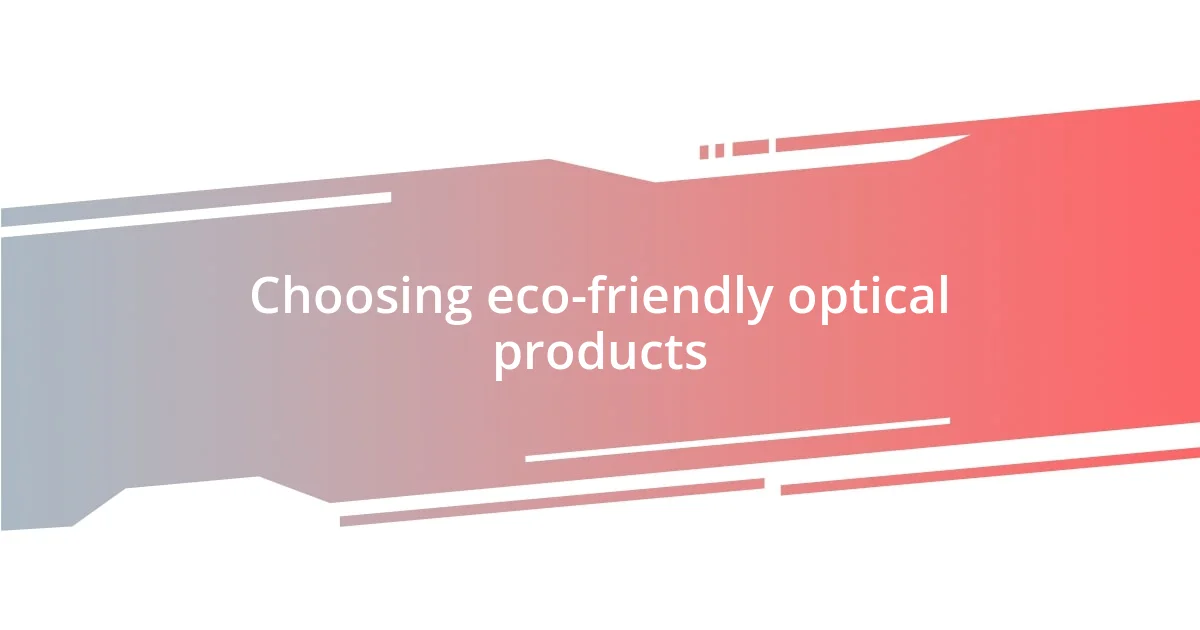Key takeaways:
- Choosing eco-friendly eyewear not only reduces waste but also cultivates a responsible consumer culture that prioritizes sustainability alongside style.
- Innovations in manufacturing processes and materials, such as biodegradable frames and recycled ocean plastics, significantly reduce the environmental footprint of optical products.
- The future of eco-friendly optics is trending towards transparency in sourcing, digital technologies for informed choices, and collaborations with environmental initiatives to promote sustainable practices.

Understanding eco-friendly optics
When I first dove into the world of eco-friendly optics, I was struck by how crucial materials are in shaping our vision. I remember replacing my old plastic frames with ones made from biodegradable materials. The difference was not just in sustainability; it felt like I was making a statement about my values, showing that style and responsibility can go hand in hand.
Understanding eco-friendly optics is about recognizing the impact of our choices. Have you ever considered how your eyewear contributes to waste? Each time we opt for sustainable options, like lenses crafted from recycled materials or frames designed for durability, we play a part in reducing our overall carbon footprint. It’s quite empowering!
Also, let’s not forget about the manufacturing processes. The methods used to produce eco-friendly optics often incorporate renewable energy and minimal waste strategies, which is something I wish more people understood. Every time I look through my eco-conscious lenses, I feel a connection to the broader environmental movement. Does that spark a sense of responsibility in you too?

Importance of sustainable materials
Sustainable materials are essential for reducing the environmental impact of optical products. I recall my fascination when I learned about frames made from recycled ocean plastics. It felt incredible to know that each pair not only served a purpose in my daily life but also contributed to cleaning up our oceans. Choosing such materials represents a shift towards a more responsible consumer culture, where we prioritize the planet alongside our personal style.
- They help conserve natural resources by utilizing recycled or renewable inputs.
- The production processes often require less energy, thereby minimizing greenhouse gas emissions.
- Sustainable materials can lead to less waste, as many are designed for durability and longevity.
- By supporting companies that use these materials, we encourage greater industry accountability and innovation.
- Investing in sustainable eyewear can shift consumer behavior, making eco-friendliness the norm rather than the exception.

Choosing eco-friendly optical products
Choosing eco-friendly optical products isn’t just a trend; it’s a lifestyle decision that resonates deeply with me. I remember the thrill of finding glasses made from sustainable bamboo, which felt incredibly light and surprisingly sturdy. Each time I wear them, I’m reminded of the bond I share with nature, knowing that my choice helps promote responsible harvesting practices.
When exploring options for eco-friendly eyewear, it’s essential to consider factors like certifications. A few key labels, such as the Forest Stewardship Council (FSC) and Global Organic Textile Standard (GOTS), can guide us toward brands that prioritize sustainability. Selecting products with these certifications not only assures quality but also reinforces my commitment to making environmentally responsible choices.
It’s fascinating how many innovative products are out there, yet many consumers are unaware. For instance, I stumbled upon lenses made from plant-based materials, which sparked my curiosity about the technology behind them. By choosing these unique offerings, we support a movement towards sustainability that can redefine industries. Have you thought about how your small actions could collectively lead to significant environmental changes?
| Eco-Friendly Material | Details |
|---|---|
| Bamboo | Lightweight, renewable, and stylish. |
| Recycled Ocean Plastics | Helps clean oceans while providing sturdy frames. |
| Plant-Based Lenses | Reduces reliance on petroleum-based products. |
| Biodegradable Frames | Breaks down naturally without harming the environment. |

Impact of manufacturing processes
The manufacturing processes involved in creating eco-friendly optical products greatly influence their overall environmental footprint. I vividly remember the day I visited a local eyewear manufacturer specializing in sustainable materials. It was eye-opening to see how they implemented water-saving techniques and reduced waste throughout production – it reaffirmed my belief that every step counts in the journey towards sustainability. What if more manufacturers adopted similar practices? It could lead to a seismic shift in the industry.
Each time I delve into the specifics of these processes, I can’t help but admire innovations that prioritize energy efficiency. For example, some manufacturers have embraced renewable energy sources, cutting down their carbon emissions significantly. This commitment isn’t just good for the planet; it also inspires others to elevate their standards. Isn’t it exciting to think that manufacturing can be both responsible and pioneering?
The attention to detail in the manufacturing phase has repercussions beyond the final product— it can also elevate the consumer’s experience. I felt a profound sense of pride when I purchased a pair of eyewear made through environmentally-conscious methods. Knowing that the frames were produced without damaging ecosystems made wearing them feel not just stylish but virtuous. How many other products could offer us that same sense of connection to the earth? By focusing on better practices, we secure a brighter, more sustainable future for everyone.

Maintenance of eco-friendly optics
Maintaining eco-friendly optics isn’t just about the initial purchase; it’s an ongoing commitment that requires care and attention. I remember the first time I noticed scratches on my eco-friendly lenses, and it felt disheartening. However, I discovered that using a microfiber cloth and a gentle cleaner makes a world of difference, extending the life of my glasses while keeping them sparkling clear. Have you experienced that sinking feeling when your favorite eyewear seems to lose its luster?
Cleaning methods matter, too. I’ve learned to steer clear of harsh chemicals often found in traditional cleaners, as they can degrade the materials used in sustainable eyewear. Instead, I rely on a simple solution of warm water and a few drops of eco-friendly soap. Not only is it safer for my frames, but it feels great knowing I’m avoiding harmful substances that could affect the environment. Have you considered how your cleaning habits can impact the lifespan of your beloved products?
Every time I take care of my eco-friendly eyewear, I reflect on the broader implications of my actions. Replacing glasses frequently can add to environmental waste, and I’ve made it a rule to schedule regular assessments of my eyewear’s condition. Is that a practice you’ve considered? Embracing maintenance not only saves me money in the long run; it aligns with my values of sustainability, allowing me to truly appreciate each pair I own.

Innovations in sustainable optics
Innovations in sustainable optics are not just intriguing; they can genuinely reshape our relationship with eyewear. During a recent workshop on eco-friendly product design, I was impressed by a start-up that used biodegradable materials for frames. It struck me how a simple shift in material choice could minimize plastic waste. Have you ever stopped to think about what happens to our discarded eyewear?
One area I find truly exciting is the advancement of lens technology. For instance, I discovered that some companies are now creating lenses from recycled ocean plastics. This initiative not only addresses waste but also promotes a cleaner ocean. It left me wondering—could this innovation inspire other industries to reuse materials creatively?
Moreover, the push for circular economy models in the optical industry is gaining momentum. I remember participating in a brand’s lens recycling program, where I returned my old lenses for a discount on new ones. This made me feel like I was part of a bigger movement towards sustainability. Wouldn’t it be amazing if more brands embraced this model, turning waste into resources? The potential for a collaborative approach to sustainability seems limitless.

Future trends in eco-friendly standards
As I look towards the future of eco-friendly standards in the optical industry, I’m struck by the increasing emphasis on transparency. Recently, I attended a conference where brands openly discussed their sourcing and manufacturing processes. Hearing them share their stories made me realize how critical it is for consumers to understand the impact of their purchases. Doesn’t it feel empowering to know exactly where your products come from and how they’re made?
Additionally, I’m excited about the rise of digital technologies that enhance sustainability. I encountered a fascinating app that allows users to visualize how sustainable their eyewear choices are, based on factors like materials and production practices. This kind of innovation creates a more informed consumer base and encourages eco-conscious decisions. Have you ever wondered how technology could influence your purchasing habits?
Looking ahead, I can’t help but think about the collaboration between eyewear brands and environmental organizations. Just last month, I participated in a tree-planting initiative organized by an eco-conscious eyewear brand. Knowing that my purchase contributed to reforestation efforts left me feeling connected to a much larger cause. What if more companies adopted similar partnerships? The potential for businesses to foster genuine environmental change is incredibly inspiring, and I believe it’s a trend that will only grow stronger.













